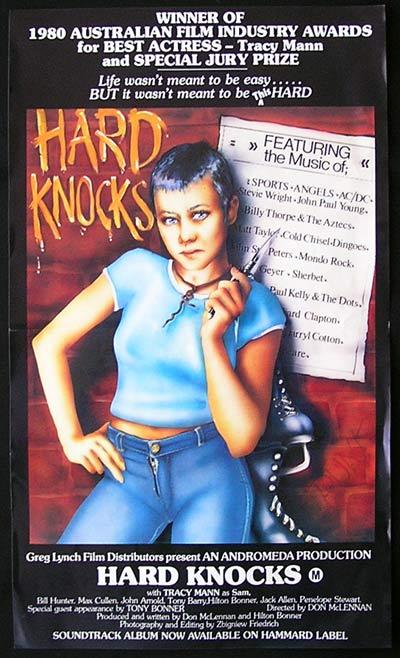
HARD KNOCKS
Australia, 1980, 80 minutes, Colour.
Tracy Mann, Tony Barry, Hilton Bonner, Bill Hunter, John Arnold, Kim Rushworth, Kirsty Grant, Elizabeth Stevenson, Penelope Stewart.
Ddirected by Don Mc Lennan.
A brief slice of Melbourne life, filmed in 16 mm. on a small budget, but well done within its limits. Running time is 80 minutes. Sam is an inner-city tough girl, assaults and robs, gets jail sentences, endures the tough life in prison, has an opportunity as a model but is knocked by exploiters, the police and her circumstances. Tracy Mann makes Sam quite credible. As in Mouth To Mouth, though less persuasively here, we are shown our urban problems and the effect on people, generally for the worse. A confusing juggling with time sequences is off-putting at first but this is the type of local film we should promote – trying to observe and dramatise something about Australia.
1. The impact of the film? Its themes and treatment? How entertaining, informative? The point of the film, its message? For what audience? Local audiences? Its universal values?
2. The initial title was 'Sam'. The emphasis of this title? The value of the change of title to 'Hard Knocks'? The change in emphases?
3. The production values? Small budget, photographing on 16 mm. film? The use of the city of Melbourne and its locations, atmosphere? City, Fitzroy? How authentic The streets, homes, the shopping complexes, prison etc.?
4. The importance of the musical score, the continued medley of contemporary songs? The importance of their lyrics commenting on the action and characters? The sounds of the music played, the tone? Audience response to the music and its relationship to themes?
5. The value of the structure of the screenplay: the time shifts, the interplay of past, present and future? How confusing? How important for editorial comment on Sam's character? How did the structure clarify itself as the film went on? The nature of the flashbacks? Editing devices eliminating flashback techniques? Flash-forwards? The insight into this kind of time shifting in presenting characters and situations? The build-up of Sam's character and her life?
6. The credits sequence and the style? The mood? Sam and Wally, the city environment, appearance, clothes, robbery, threatened violence? The comparison with the ending and Sam's room being destroyed Her reaction ar d her being left alone? Possibilities of hope hopelessness? Sam's final rage? Why should such things happen?
7. The portrait of Sam? Tracy Mann's skill in providing the portrait? As a young girl: Her shaved head, youthfulness, language, dress, resourcefulness, robberies, violence, escaping from the police – leaving her blouse with the poliae etc.? Her being cornered in the street? Her prison sentence – and the friendship with Raelene and Debbie? The lasting effects of these friendships? Raelene later teaming up with Wally and having the child? Debbie and her dependence on drugs, Sam's rejection of her from staying the night? Getting out of prison, the encounter with Frank, the plans for the robbery? Hiring the men, the execution of the robbery at the service station, the threatened violence? Her being arrested? The term in prison and her learning a career, the modelling lessons? Her abilities to help other prisoners? Joan's help? Her life as a model – the photography sessions in the park, the modelling of the clothes at the shopping centre? Her relationship with her father and his appearances and disappearances, playing the piano, her rage with him? Her relationship with men – love, casual relationships? Her work in the restaurant? An outline of these years of her life, development, growth, frustration? How valuable a portrait of a girl in a modern city?
8. Sam and the quality of her friendships and love: with Wally and the initial robbery, meeting him again with Raelene, exasperation with him, friendship? Raelene and her stammer, trailing along in prison, being the butt of Debbie's jokes, the child and its fatherhood? Her friendship with Debbie and its being tested when Debbie escaped from prison? Joan and her help, her getting her opportunities, allowing her to be exploited by the photographer – the nude modelling, the suggestions for prostitution work? Her friendship with Tim, drugs, the sexual relationship, her liking for him? Frank and the robberies? How well delineated were these supporting characters – in themselves, in relationship to Sam?
9. The picture of the police – Brady and his associate? Their stopping Sam and Wally, Sam's escape but her being cornered? The second arrest and the harsh interrogation, the cigarette torture? The encounter with Brady at the restaurant and Sam's humiliation of him in front of his wife? His revenge on her? His letting her go but the smashing of her room? The ugly picture of the police – how justified?
10. Life in prison, the room with Raelene and Debbie, the chatter of the girls in the prison, their work, the learning of modelling?
11. Sam and her getting her own flat, her relationship with her father and his piano-playing and laziness? The relationship with Frank? Tim and the group? The encounter with the photographer and his soliciting her? Joan and her disillusionment with her? The other girls from the modelling?
12. The build-up to the end – the encounter with Brady, the humiliation, the violence and Brady's power over her, her being hurt by the destructiveness in her room? The point of leaving Sam at this juncture?
13. The picture of Australian society, the background of the 70s and opportunities, unemployment, education? Appearances and reality and audience judgment The place of the police and authority figures? Hope and despair? The value of this kind of slice of life and its message for the community and its critique of society?